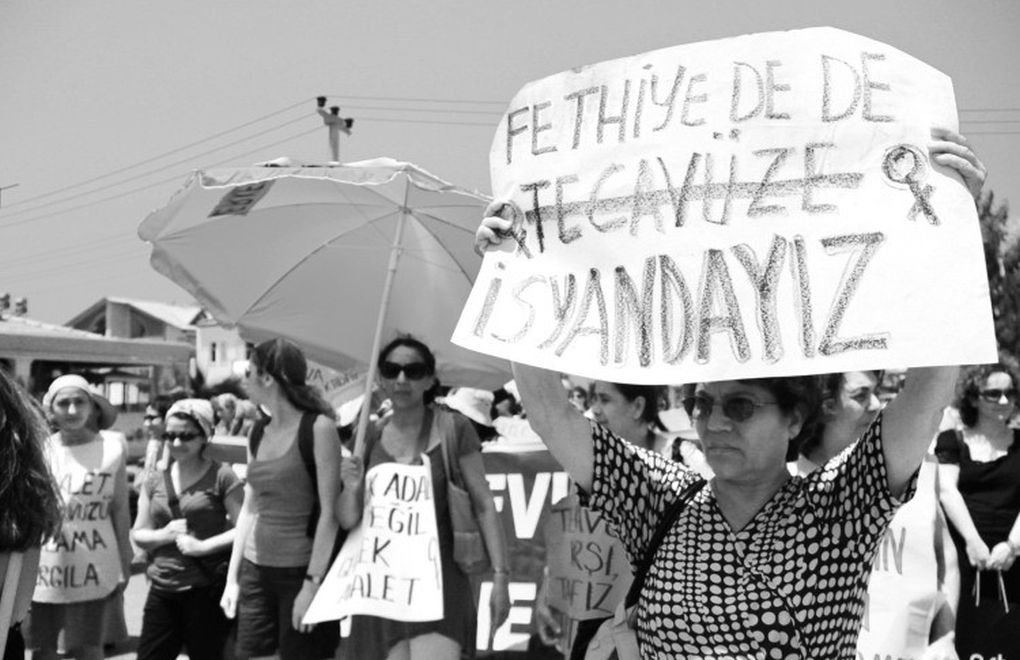"We rise up against rape in Fethiye as well" (on csgorselarsiv.org - by Özge Özgüner)
Click to read the article in Turkish / Kurdish
Before we start...Sexual violence is, unfortunately, always a pressing issue. We, very often, witness flawed and false information about different dimensions of the issue. It needs to be clearly expressed that the lack of awareness of individuals and society, patriarchal order and gender inequality, taboos and myths, the allegations voiced by perpetrators to portray the victims of sexual violence as guilty and to manipulate the public opinion and the problems in the functioning of judicial processes lead the victims to be hurt for yet another time, cause the violence to be reproduced and handed down from generation to generation and undermine the health of both individuals and society. We, as five psychiatrists, have come together with a sense of responsibility to inform the public correctly about the issue. In this file, we would like to compile information regarding what sexual violence is, what myths there are about this issue, what leads sexual violence to be ignored and prevents the ones subjected to sexual violence from declaring it, the remedial effect of justice and the consequences of the files taken to court. Dr. Ebru Toprak Dr. Özlem Altuntaş Dr. Arzu Erkan Yüce Dr. Çiğdem Çolak Kalaycı Dr. Burcu Rahşan Erim |
Sexual violence is a grave violation of fundamental human rights. "Sexual violence" can be defined as using sexuality as a means of violence to contain, control, humiliate, degrade or punish a person.
People are frequently subjected to sexual violence following physical violence. However, most of the time, they cannot report sexual violence due to feelings of shame and guilt.
That is why, it is known that even though sexual violence is quite widespread in and out of wedlock, the studies find much lesser rates of sexual violence, when compared with other forms of violence.
Forms of sexual violence
Raping a person,
Forcing a person to have a sexual intercourse,
Forcing a person to undesired sexual positions,
Pretending not to hear "No",
Having a sexual intercourse in a rude and hurting manner even though the person does not have consent to it,
Forcing the person to have a sexual intercourse by making him or her use medication, alcohol or drugs,
Forcing the person to have a sexual intercourse and touching his or her sexual spots in undesired ways and at undesired times,
Using sexuality as a method of punishment/ reward,
Forcing the person to have a sexual intercourse with others,
Forcing the person to do sex work,
Forcing the person to watch or to be watched while having a sexual intercourse with other people,
Trying to get the person's consent through threat or intimidation,
Enjoying sexuality according to one's own wishes and desires, while ignoring the needs and expectations of the other person,
Verbally and physically harassing, exposing, forcing the person to watch pornographic images and videos,
Stalking and disturbing the person by sending sexually explicit materials or messages on the phone, Internet, etc.,
Capturing images and videos without the person's consent when naked and/or having a sexual intercourse, sharing these images and videos and threatening the person with sharing them,
Speaking in a humiliating manner about the person's body and sexuality,
are common types of sexual violence (1).
These behaviors harm the person physically, psychologically, emotionally and socially. Sexual crimes are more frequently used as a tool of using violence, using force and displaying power through another person. Sexual violence might have been inflicted by persuading, cajoling, threatening the person or with methods involving force. Only dealing with sexuality falls short when it comes to preventing the repetition of these acts (2).
Types
Sexual violence can be grouped under the sub-categories of sexual abuse, harassment and sexual assault/ rape.
Sexual abuse is any type of sexual behavior that is displayed without the consent of one of the persons. When children are concerned, consent is out of the question. Any type of sexual behavior targeting a person below the age of 18 is considered "sexual abuse." The sole responsible party for these actions is the one who took them (3).
Harassment does not mean flirting, making advances or being misunderstood! Flirting leads one to have positive feelings; if it is harassment, the one subjected to it has negative feelings and feels under pressure. No means "No"; it does not mean feigning reluctance or that "No" will turn into "Yes" after some time. In that sense, when a person is sent insisting messages, even if not sexually explicit ones, despite being disturbed, when he or she is constantly called, stalked on social media and sent flowers, it means harassment.
Harassment, as some male harassers sometimes put it, is not "the enjoyable part" of it or a "joke." Attempts to normalize it with such statements as "He is a bit into women, he is a bit flirtatious" must be avoided (4).
Sexual assault: When a behavior takes a physical dimension, it is sexual assault.
Rape: It involves vaginal, anal and oral penetration and the attempts to do so (3).
Incest and intramarital rape are two of the most common types of sexual violence. As in the case of domestic violence, the persons subjected to this form of violence usually avoid talking about it.
67 percent of the ones who say that they are subjected to sexual violence indicate that they are subjected to physical violence as well (5).
When we consider all of these points, we see how wide the scope and prevalence of sexual violence is and how rarely it is voiced. (ET/EMK/NÖ/SD)
Recommendations for further reading in Turkish:
- Mor Çatı Kadın Sığınağı Vakfı, 2020
- Türkiye Psikiyatri Derneği Kadın Ruh Sağlığı çalışma Birimi Basın Açıklamaları.
- Psikiyatrist Prof.Dr. Şahika Yüksel- Bianet 2020 Cinsel Saldırılarda Profesyonel Tanıklık.
- Ulusal Psikiyatri Kongresi Kadın Ruh Sağlığı Çalışma Grubu Raporu- 2019.
- Gülseren L, Başterzi AD, Gündelik Yaşamdan Kliniğe Şiddet ve Psikiyatri içinde. Editör: Leyla Gülseren (Ed.) 1. Baskı, Ankara, Türkiye Psikiyatri Derneği Yayınları, s.55-87, 2017.






